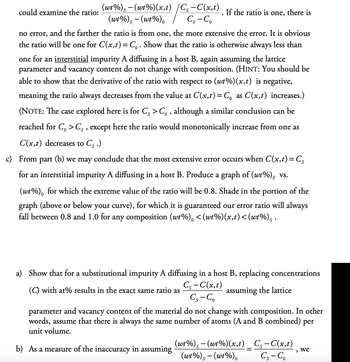
Principles of Heat Transfer (Activate Learning with these NEW titles from Engineering!)
8th Edition
ISBN: 9781305387102
Author: Kreith, Frank; Manglik, Raj M.
Publisher: Cengage Learning
expand_more
expand_more
format_list_bulleted
Question
Solve this and show all of the work

Transcribed Image Text:(wt%)-(wt%)(x,t) /Cs-C(x,t)
could examine the ratio:
If the ratio is one, there is
(wt%) -(wt%)
CS-Co
S
no error, and the farther the ratio is from one, the more extensive the error. It is obvious
the ratio will be one for C(x,t) = Co. Show that the ratio is otherwise always less than
one for an interstitial impurity A diffusing in a host B, again assuming the lattice
parameter and vacancy content do not change with composition. (HINT: You should be
able to show that the derivative of the ratio with respect to (wt%) (x,t) is negative,
meaning the ratio always decreases from the value at C(x,t) = C₁ as C(x,t) increases.)
(NOTE: The case explored here is for Cs > Co, although a similar conclusion can be
reached for Co > Cs, except here the ratio would monotonically increase from one as
C(x,t) decreases to Cs.)
c) From part (b) we may conclude that the most extensive error occurs when C(x,t) = Cs
for an interstitial impurity A diffusing in a host B. Produce a graph of (wt%)s vs.
(wt%), for which the extreme value of the ratio will be 0.8. Shade in the portion of the
graph (above or below your curve), for which it is guaranteed our error ratio will always
fall between 0.8 and 1.0 for any composition (wt%), <(wt%)(x,t)<(wt%)s ·
a) Show that for a substitutional impurity A diffusing in a host B, replacing concentrations
(C) with at% results in the exact same ratio as
C₁-C(x,t)
CS-Co
assuming the lattice
parameter and vacancy content of the material do not change with composition. In other
words, assume that there is always the same number of atoms (A and B combined) per
unit volume.
b) As a measure of the inaccuracy in assuming
(wt%)s-(wt%)(x,t) _ Cs-C(x,t)
(wt%)-(wt%)
we
,
Cs-Co
Expert Solution
This question has been solved!
Explore an expertly crafted, step-by-step solution for a thorough understanding of key concepts.
Step by stepSolved in 2 steps

Knowledge Booster
Similar questions
- 10 / 36 110% LQ23]( problem 지25's p37) Exepe20-원 At What angle &' must the (400N) force be applied in order to that the resultant `R of the two 400 N forces has a of (1000 N)? magnitude What will be the angle o between 700 N R and the horizontal (x-axis) ? Ane ∞ = 51.3° 0 = 18 19° P Type here to searcharrow_forward4. If the (mvnax = hf – W), Prove that by using the scale units of each quantities. %3Darrow_forwardPlease help me answer #8. A and b. Thank you!arrow_forward
- Gggarrow_forwardT = 100 + 5x lb/in. %3D Given the bar element's linear shape, or interpolation functions are: N1= 1-x/L , and N2= x/L (where Lis the element length), determine the energy equivalent nodal forces for the axial distributed loading shown acting on the bar element below. 10 in.arrow_forwardDerive the seven general property equation of the following thermodynamics processes: a. ISOMETRICPROCESSarrow_forward
- Just B and C Pleasearrow_forwardbliuzodt to mopolb 9. If machine parts are degreased by means of kerosene as shown in the diagram, how much kerosene make-up is needed per day? How much kerosene has to enter the degreasing vat per day? There are about 3 lb of grease per 100 lb of machine parts, and 60 tons of machine parts are processed each day. Five thousand pounds of kerosene (the 10% solution) are carried away by the machine parts each day but drip off and are caught and put back in the degreasing vat. Two hundred pounds of the 10% solution are lost each day from the vat by evaporation, spillage, or by being carried away.arrow_forwardPlease write solution on paper, thank you. No typing, it's very hard to follow. I'll give positive feedbackarrow_forward
arrow_back_ios
SEE MORE QUESTIONS
arrow_forward_ios
Recommended textbooks for you
 Principles of Heat Transfer (Activate Learning wi...Mechanical EngineeringISBN:9781305387102Author:Kreith, Frank; Manglik, Raj M.Publisher:Cengage Learning
Principles of Heat Transfer (Activate Learning wi...Mechanical EngineeringISBN:9781305387102Author:Kreith, Frank; Manglik, Raj M.Publisher:Cengage Learning

Principles of Heat Transfer (Activate Learning wi...
Mechanical Engineering
ISBN:9781305387102
Author:Kreith, Frank; Manglik, Raj M.
Publisher:Cengage Learning